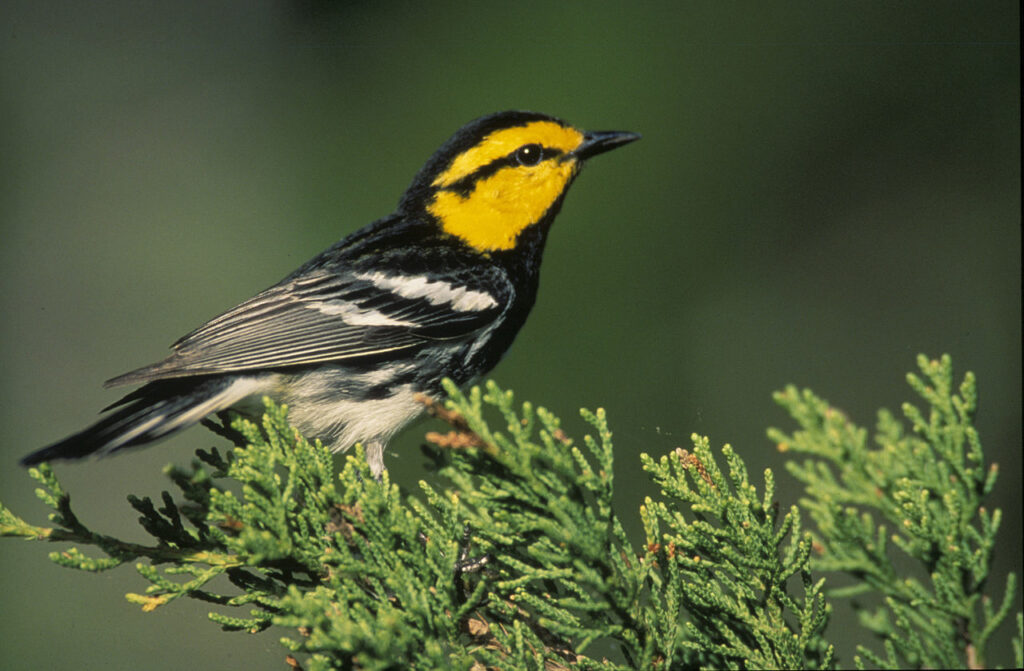Bad science and corrupt bureaucrats turned a beautiful migratory songbird that nests only in Texas into a 1990s terror that good science and concerned citizens are now fighting to exonerate.
The songbird is the golden-cheeked warbler and the fear it instills comes from its status as an endangered species protected by a bureaucracy that confiscates property, bankrupts businesses and imprisons decent people – and we now know that the warbler was never endangered at all.
A coalition of three groups, Texans for Positive Economic Policy, the Texas Public Policy Foundation and the Reason Foundation, hand-delivered a petition to U.S. Fish and Wildlife Service (FWS) offices in Washington, DC, requesting that the warbler be removed from the endangered list, citing verified scientific evidence of ample populations and abundant habitat.
The official story is that the golden-cheeked warbler was erroneously believed to be rapidly going extinct when the U.S. Fish and Wildlife Service listed it under the Endangered Species Act in 1990 on an emergency basis. The FWS claimed the warbler’s best breeding habitat was primarily in the mature juniper nesting trees of the Hill Country that spreads westward from the outskirts of Austin, a bungled guess based on outmoded 10-year-old satellite mapping and an unverified 14-year-old study of warbler density.
The details are not so innocent: the golden-cheeked warbler listing petition was a handwritten document dated February 1, 1990, signed “Timothy Jones, Earth First!” (the vandalism-and-arson radical group). The petition wasn’t challenged by the FWS addressee, Alisa Shall, Wildlife Biologist, or anyone else in the agency. The warbler was simply listed upon Jones’ request.
The listed warbler instantly became a weapon for the FWS to restrict landowners’ use of their property and even jeopardized military training. And some federal officials frightened landowners into selling at panic prices to environmental groups.
Margaret Rodgers, an elderly lady who owned a ranch west of Austin, was clearing a fencerow of invading young junipers so she could rebuild the fence they were pushing down so badly that her livestock got out – a familiar problem to Hill Country ranchers. An informer told FWS Field Supervisor Robert M. Short, who wrote to Mrs. Rodgers in December 1990, that her property “supports prime habitat for the federally-listed endangered golden-cheeked warbler,” and threatened her with criminal and civil penalties for cutting the 6-foot high junipers (hardly “prime habitat”): “Section 11(b)(1) provides for a fine of not more than $50,000 or imprisonment up to one year, or both.”
Mrs. Rodgers immediately warned fellow ranchers of Short’s threat and something odd: The Nature Conservancy had already bought out adjoining parcels of the ranch owned by relatives, and she had just refused a lowball offer from the Conservancy to buy her land. Nobody believed that the timing of the Nature Conservancy’s offer and Field Supervisor Short’s letter were coincidence.
Brian Seasholes, director of Reason Foundation’s Endangered Species Project and part of the effort to save the golden-cheeked warbler from its fearsome status, has new, thorough, and accurate data that indicates the warbler’s habitat and population are much greater than the FWS believed in 1990.
Seaholes wrote in the Daily Caller that “a number of peer-reviewed studies published in the early 2010s, primarily by researchers at Texas A & M University, document that compared to 1990 the warbler’s population is nineteen times larger, breeding habitat is five times larger and much more widely distributed, and the warbler can breed in a much wider range of habitat types.”
He believes that “all of this scientific research is a slam dunk because there is no basis for keeping the warbler listed under the Endangered Species Act.”
But bureaucrats don’t willingly surrender their power, and Seasholes sees “strong indications” that the Fish and Wildlife Service will “try to fight reality in order to keep the warbler listed,” and, of course, to keep their bullying authority intact.
The Washington, D.C.-based Marzulla Law Firm, arguably the premiere property rights law firm in the nation, was the clear and obvious choice to put together the petition to delist the golden cheeked warbler.
Robert Henneke, director of the Center for the American Future at the Texas Public Policy Foundation says, “we consider state and local conservation efforts as being of greater benefit to the warbler and that continued ESA regulation can impede voluntary and local conservation efforts.”
One of the petitioners, Susan Combs, is a fourth generation Texan with astonishing experience, having served as a state representative, agriculture commissioner, and most recently, as state comptroller for public accounts. Combs has devoted her career to Endangered Species Act issues, heading the state task force on endangered species.
This is a formidable coalition backed with formidable scientific and legal talent, all up against a formidable bureaucracy more interested in its own power than the welfare of the nature it is charged to protect.





